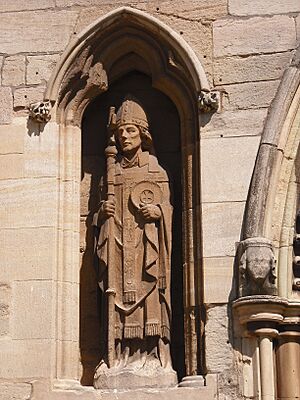Wulfram of Sens facts for kids
Quick facts for kids SaintWulfram of Sens |
|
|---|---|

St. Wulfram statue at his church in Grantham, Lincolnshire.
|
|
| Confessor | |
| Born | c. 640 probably Milly-la-Forêt, Essonne, in now France |
| Died | 20 March 703 Fontenelle, Kingdom of the Franks (now France) |
| Venerated in | Roman Catholic Church, Anglican Communion, Eastern Orthodox Church |
| Major shrine | Abbeville; Grantham |
| Feast | 20 March 15 October (Translation of his mortal remains) |
| Attributes | Bishop baptizing a young king; cleric with a young king nearby; cleric arriving by ship with monks and baptizing a king; baptizing the son of King Radbod |
| Patronage | Abbeville, France |
Wulfram of Sens or Wulfram of Fontenelle (also Vuilfran, Wulfrann, Wolfran; Latin: Wulframnus; French: Vulfran or Vulphran; c. 640 – 20 March 703) was the Archbishop of Sens. His life was recorded eleven years after he died by the monk Jonas of Fontenelle. However, there seems to be little consensus about the precise dates of most events whether during his life or post mortem.
Wulfram is depicted in art as baptising a young king or the son of King Radbod. Sometimes the young king is near him and sometimes Wulfram is shown arriving by ship with monks to baptise the king. There are two churches dedicated to him in England, at Grantham, Lincolnshire, and Ovingdean, Sussex, and two in France, one at Abbeville, in the département of Somme, the other in Butot, in the département of the Seine Maritime. As a patron saint, he protects against the dangers of the sea.
Early life
Wulfram was born in the diocese of Meaux, at Mauraliacus, an insecurely identified place near Fontainebleau, probably Milly-la-Forêt, Essonne. He was the son of a certain Fulbert, a knight attached to the court of Dagobert I, king of the Franks. King Dagobert's kingdom was divided on his death, and it was close to the court of his partial successor, Clovis II, king of Neustria and Burgundy that Wulfram is likely to have been born a little after Dagobert had died in 639.
Wulfram was educated at Clovis' court and showed a gift for academic learning. He took holy orders and seems to have intended a quiet life but was called to the court of Theodoric III (Thierry III) of Neustria. This seems to have propelled him into greater prominence since, in 692, he was elected Archbishop of Sens. There are various versions of the date for this, the earliest being in 682. However, by 693 he was in the post as he attended an assembly of bishops at Valenciennes.
In 695, he resigned the archbishopric in favor of Amatus of Nusco, who, it seems, he thought would be better at that sort of work, and retired to the Benedictine abbey called "Fontenelle". There are several places called Fontenelle, but this was probably at St-Wandrille, near Caudebec-en-Caux on the lower Seine, in the Diocese of Rouen. However, Johannes Madey places it at Fontenelle in the extreme north of the département of Aisne.
The mission in Friesland
It is said } that when Boniface withdrew from his missionary work in Friesland, in order to visit Rome for the second time, Wulfram stood in for him in Friesland. However, Boniface was a younger contemporary, his first and abortive mission in Frisia began in 716 or so, probably after Wulfram had died.
Whatever the order of these events, in Frisia, Wulfram converted the son of King Radbod and was allowed to preach. Wulfram saved three people who had been chosen to be sacrificed to the local gods. One of them, Ovon, became Wulfram's slave, his follower, a monk, and then a priest at Fontenelle Abbey. The faith of the missionaries (and their power to work miracles) frightened and awed the people, who were baptized and turned away from paganism.
Even Radbod seemed ready for conversion, but just before his baptism, he asked where his ancestors were. Wulfram told him that idolaters went to Hell. Rather than be apart from his ancestors, he chose to stay as he was.
Wulfram's death and after
He retired to Fontenelle, where he died in 703. His year of death is sometimes given as 720, but his interred body is said to have been moved in 704. Regardless of the exact year, Saint Wulfram's feast day is kept on 20 March. He was buried in St. Paul’s chapel in the abbey, but in 704, he was re-buried in the main church. The body was again moved in 1058, this time to the collegiate church of Our Lady in Abbeville, which was then re-dedicated in Wulfram's name. The translation of his body to Abbeville is commemorated on 15 October.
At about this time or later, perhaps when his body was again moved, this time to Rouen, his arm was taken as a relic to Croyland Abbey, Lincolnshire. After the building at Crowland was damaged by fire, there was no longer a suitable place for keeping the relic, so it went to Grantham for safe-keeping. For two or three hundred years, it was kept in the crypt chapel below the Lady Chapel, where the pilgrims helped to wear the hollow, now to be seen in stone step before the altar. Later, towards 1350, the arm went to the specially added chapel above the north porch. At some stage in the long process of the English Reformation, this relic was lost.
See also
- Frisian-Frankish wars



